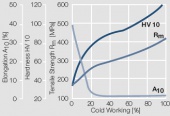Brazing Alloys
For the joining of contact materials with carrier substrates, brazing alloys with working temperatures > 600 °C are used exclusively. The working temperature is defined as the lowest surface temperature, by which the brazing material wets the materials to be joined. This temperature is within the melting range and between the solidus (temperature at which melting starts) and liquidus (temperature at complete liquid state) point of the brazing alloy. Silver-based brazing alloys have good electrical co...


